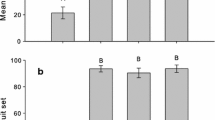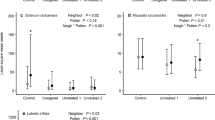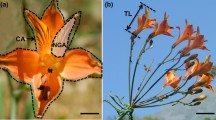Abstract
The co-occurrence of plant species within a community is influenced by local deterministic or neutral processes as well as historical regional processes. Floral trait distributions of co-flowering species that share pollinators may reflect the impact of pollinator preference and constancy on their assembly within local communities. While pollinator sharing may lead to increased visitation rates for species with similar flowers, the receipt of foreign pollen via interspecific pollinator movements can decrease seed set. We investigated the pattern of community flower colour assembly as perceived by native honeybee pollinators within 24 local assemblages of co-flowering Oxalis species within the Greater Cape Floristic Region, South Africa. To explore the influence of pollinators on trait assembly, we assessed the impact of colour similarity on pollinator choices and the cost of heterospecific pollen receipt. We show that flower colour is significantly clustered within Oxalis communities and that this is not due to historical constraint, as flower colour is evolutionarily labile within Oxalis and communities are randomly structured with respect to phylogeny. Pollinator observations reveal that the likelihood of pollinators switching between co-flowering species is low and increases with flower colour similarity. Interspecific hand pollination significantly reduced seed set in the four Oxalis species we investigated, and all were dependant on pollinators for reproduction. Together these results imply that flower colour similarity carries a potential fitness cost. However, pollinators were highly flower constant, and remained so despite the extreme similarity of flower colour as perceived by honeybees. This suggests that other floral traits facilitate discrimination between similarly coloured species, thereby likely resulting in a low incidence of interspecific pollen transfer (IPT). If colour similarity promotes pollinator attraction at the community level, the observed clustering of flower colour within communities might result from indirect facilitative interactions.




Similar content being viewed by others
References
Ackerly DD (2003) Community assembly, niche conservatism, and adaptive evolution in changing environments. Int J Plant Sci 164:S165–S184
Anderson S (2003) Foraging responses in the butterflies Inachis io, Aglais urticae (Nymphalidae), and Gonepteryx rhamni (Pieridae) to floral scents. Chemoecology 13:1–11
Armbruster WS, Edwards ME, Debevec EM (1994) Floral character displacement generates assemblage structure of Western Australian trigger plants (Stylidium). Ecology 75:315–329
Arnold SEJ, Savolainen V, Chittka L (2009) Flower colours along an alpine altitude gradient, seen through the eyes of fly and bee pollinators. Arthropod Plant Interact 3:27–43
Bradshaw HD, Schemske DW (2003) Allele substitution at a flower color locus produces a pollinator shift in monkey flowers. Nature 426:176–178
Brown JH, Kodric-Brown A (1979) Convergence, competition and mimicry in a temperate community of humming bird-pollinated flowers. Ecology 60:1022–1035
Brown BJ, Mitchell RJ (2001) Competition for pollination: effects of pollen of an invasive plant on seed set of a native congener. Oecologia 129:43–49
Brown WL, Wilson EO (1956) Character displacement. Syst Zool 5:49–64
Chittka L (1992) The color hexagon: a chromaticity diagram based on photoreceptor excitations as a generalized representation of color opponency. J Comp Physiol 170:533–543
Chittka L (1996) Optimal sets of color receptors and color opponent systems for coding of natural objects in insect vision. J Theor Biol 181:179–196
Chittka L, Spaethe J, Schnidt A, Hickelberger A (2001) Adaptation, constraint, and chance in the evolution of flower color and pollinator color vision. In: Chittka L, Thomson JD (eds) Cognitive ecology of pollination: animal behaviour and floral evolution. Cambridge University Press, Cambridge, pp 106–126
Dreyer LL, Makgakga MC (2003) Oxalidaceae. In: Germishuizen G, Meyer NL (eds) Plants of Southern Africa: an annotated checklist, Strelitzia vol 14. National Botanical Institute, Pretoria, pp 174–194R ISBN 1-919795-99-5
Dyer AG, Chittka L (2004) Fine colour discrimination requires differential conditioning in bumblebees. Naturwissenschaften 91:224–227
Feinsinger P, Busby WH (1987) Pollen carryover: experimental comparisons between morphs of Palicourea lasiorrachis (Rubiaceae), a distylous, bird-pollinated, tropical treelet. Oecologia 73:231–235
Frey FM (2004) Opposing natural selection from herbivores and pathogens may maintain floral-color variation in Claytonia virginica (Portulaceae). Evolution 58:2426–2437
Gegear RJ, Laverty TM (2001) The effect of variation among floral traits on the flower constancy of pollinators. In: Chittka L, Thomson JD (eds) Cognitive ecology of pollination: animal behaviour and floral evolution. Cambridge University Press, Cambridge, pp 1–20
Gegear RJ, Laverty TM (2005) Multicomponent floral signals elicit selective foraging in bumblebees. Naturwissenschaften 92:269–271
Ghazoul J (2006) Floral diversity and the facilitation of pollination. J Ecol 94:295–304
Groom MJ (1998) Allee effects limit population viability of an annual plant. Am Nat 151:487–496
Hill PSM, Wells PH, Wells H (1997) Spontaneous flower constancy and learning in honeybees as a function of color. Anim Behav 54:615–627
Hubbell SP (2001) The unified neutral theory of biodiversity and biogeography. Princeton University Press, Princeton
Internicola AI, Page PA, Bernasconi G, Gigord LDB (2007) Competition for pollinator visitation between deceptive and rewarding artificial inflorescences: an experimental test of the effects of floral colour similarity and spatial mingling. Funct Ecol 21:864–872
Irwin RE, Strauss SY, Stroz S, Emerson A, Guibert G (2003) The role of herbivores in the maintenance of a color polymorphism in wild radish. Ecology 84:1733–1743
Johnson SD, Peter CI, Nilsson LA, Agren J (2003) Pollination success in a deceptive orchid is enhanced by co-occurring rewarding magnet plants. Ecology 84:2919–2927
Keaser T, Bilu Y, Motro U, Shimda A (1997) Foraging choices of bumblebees on equally rewarding artificial flowers of different colors. Isr J Plant Sci 45:223–233
Keddy PA (1992) Assembly and response rules: two goals for predictive community ecology. J Veg Sci 3:157–164
Kohn J, Waser NM (1985) The effect of Delphinium nelson pollen on seed set in Ipomopsis aggregate, a competitor for hummingbird pollination. Am J Bot 72:1144–1148
Kunin WE (1993) Sex and the single mustard: population density and pollinator behavior effects on seed-set. Ecology 74:2145–2160
Levin DA, Brack ET (1995) Natural-selection against white petals in Phlox. Evolution 49:1017–1022
Moeller DA (2004) Facilitative interactions among plants via shared pollinators. Ecology 85:3289–3301
Moragues E, Traveset A (2005) Effect of Carpobrotus spp. on the pollination success of native plant species of the Balearic Islands. Biol Conserv 122:611–619
Morales CL, Traveset A (2008) Interspecific pollen transfer: magnitude, prevalence and consequences for plant fitness. Crit Rev Plant Sci 27:221–238
Muchhala N, Potts MD (2007) Character displacement among bat-pollinated flowers of the genus Burmeistera: analysis of mechanism, process and pattern. Proc Roy Soc Lond B 274:2731–2737
Oberlander KC (2008) Molecular systematic study of the Southern African Oxalis (Oxalidaceae) (Ph.D. dissertation). Stellenbosch University, Stellenbosch
Pauw A (2006) Floral syndromes accurately predict pollination by a specialized oil-collecting bee (Rediviva peringueyi, Melittidae) in a guild of South African Orchids (Coryciinae). Am J Bot 93:917–926
Raine NE, Chittka L (1997) Flower constancy and memory dynamics in bumblebees (Hymenoptera: Apidae: Bombus). Entomologica Ger 29:179–199
Rausher MD, Fry JD (1993) Effects of a locus affecting floral pigmentation in Ipomoea purpurea on female fitness components. Genetics 134:1237–1247
Sanderson CE, Orozco BS, Hill PSM, Wells H (2006) Honeybee (Apis mellifera ligustica) response to differences in handling time, rewards and flower colours. Ethology 112:937–946
Sargent RD, Ackerly DD (2008) Plant–pollinator interactions and the assembly of plant communities. Trends Ecol Evol 23:123–130
Simms EL, Bucher MA (1996) Pleiotropic effects of flower–color intensity on herbivore performance on Ipomoea purpurea. Evolution 50:957–963
Strong DR, Szyska LA, Simberloff DS (1979) Tests of community-wide character displacement against null hypotheses. Evolution 33:897–913
Tilman D (2004) Niche tradeoffs, neutrality, and community structure: a stochastic theory of resource competition, invasion, and community assembly. Proc Natl Acad Sci USA 101:10854–10861
Vamosi SM, Heard SB, Vamosi JC, Webb CO (2009) Emerging patterns in the comparative analysis of phylogenetic community structure. Mol Ecol 18:572–592
Warren J, MacKenzie S (2001) Why are all color combinations not equally represented in as flower–color polymorphisms? New Phytol 151:237–241
Webb CO, Ackerly DD, McPeek MA, Donoghue MJ (2002) Phylogenies and community ecology. Annu Rev Ecol Syst 33:475–505
Webb CO, Ackerly DD, Kembel SW (2004) Phylocom: software for the analysis of community phylogenetic structure and character evolution, with phylogeny tools. http://www.phylodiversity.net/phylocom
Weither E, Keddy PA (1995) The assembly of experimental wetland communities. Oikos 73:323–335
Zietsman J, Dreyer LL, Janse Van Vuuren B (2009) Genetic differentiation in Oxalis (Oxalidaceae): a tale of rarity and abundance in the Cape Floristic Region. S Afr J Bot 75:27–33
Acknowledgments
The authors thank C. Peter for the use of his beespace model, K. Oberlander for help with Oxalis phylogeny, and F. Roets and I. Singh for assistance in the field. The Stellenbosch municipality provided permission to work in the Jan Marais Nature Reserve, and Cape Nature provided permits. Spencer Barrett and two anonymous reviewers provided helpful comments on previous versions of the manuscript. This study was funded by Stellenbosch University (to AGE) and the NRF (to LLD, Gun number 2053585). All experiments conducted comply with the current laws of South Africa.
Author information
Authors and Affiliations
Corresponding author
Additional information
Communicated by Peter Clarke.
Electronic supplementary material
Below are the links to the electronic supplementary material.
Rights and permissions
About this article
Cite this article
de Jager, M.L., Dreyer, L.L. & Ellis, A.G. Do pollinators influence the assembly of flower colours within plant communities?. Oecologia 166, 543–553 (2011). https://doi.org/10.1007/s00442-010-1879-7
Received:
Accepted:
Published:
Issue Date:
DOI: https://doi.org/10.1007/s00442-010-1879-7




